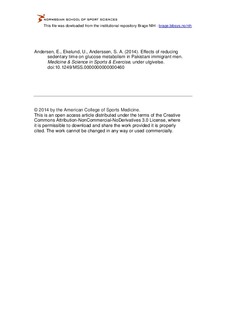| dc.description.abstract | Purpose: This study aimed to examine the association between changes in objectively measured overall physical activity (PA) and changes in fasting and postprandial plasma insulin, C-peptide, and glucose concentrations in type 2 diabetes-prone immigrant Pakistani men living in Norway and to examine whether this association is explained by changes in moderate and vigorous PA (MVPA) or changes in sedentary time.
Methods: The current study is a secondary cohort analysis on data collected from the Physical Activity and Minority Health study, a randomized controlled trial aimed at increasing the PA level, and not sedentary time per se, in a group of sedentary immigrant Pakistani men (n = 150). For the present analyses, the two groups were merged and a cohort analysis was performed. Overall PA (counts per minute) and its subcomponents, sedentary time and MVPA, were measured with accelerometry. Outcome variables were measured after a 2-h standardized glucose tolerance test.
Results: Change in overall PA was significantly associated with postprandial log-transformed plasma insulin ([beta] = -0.002; 95% confidence interval (CI), -0.003 to 0.000; P = 0.008), C-peptide ([beta] = -2.7; 95% CI, -4.9 to -0.5; P = 0.01), and glucose concentration ([beta] = -0.006; 95% CI, -0.01 to -0.002; P = 0.002). Change in sedentary time was significantly and beneficially associated with changes in postprandial log-transformed plasma insulin ([beta] = 0.002; 95% CI, 0.001–0.003; P = 0.001), C-peptide ([beta] = 3.7; 95% CI, 1.5–6.0; P = 0.001), and glucose concentration ([beta] = 0.006; 95% CI, 0.002–0.1; P = 0.002), independent of changes in MVPA, waist circumference, and other confounders.
Conclusions: Increasing overall PA by reducing sedentary time seems as important as increasing time spent at MVPA in relation to postprandial plasma insulin and glucose levels in diabetes-prone immigrant men. | nb_NO |
